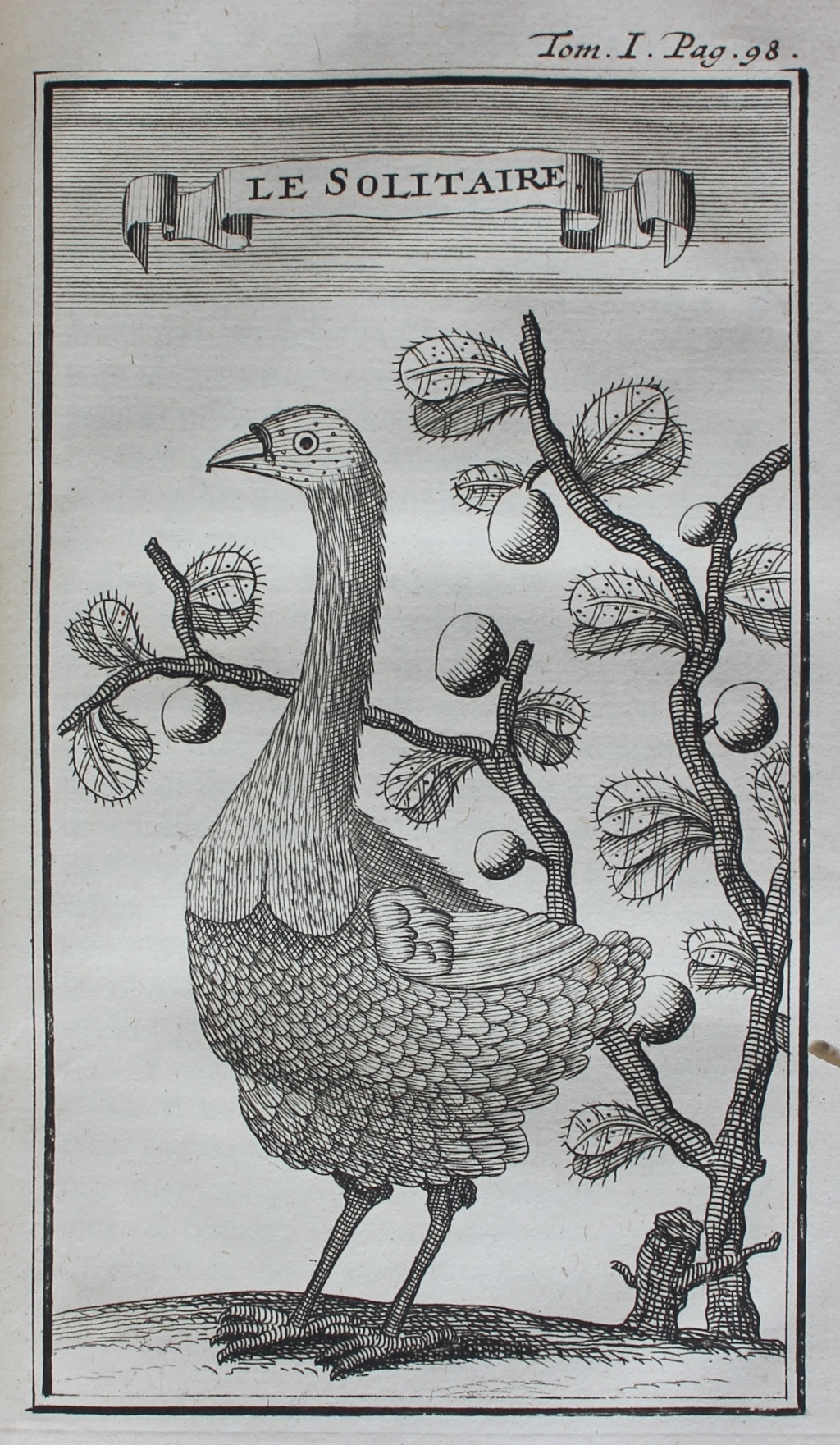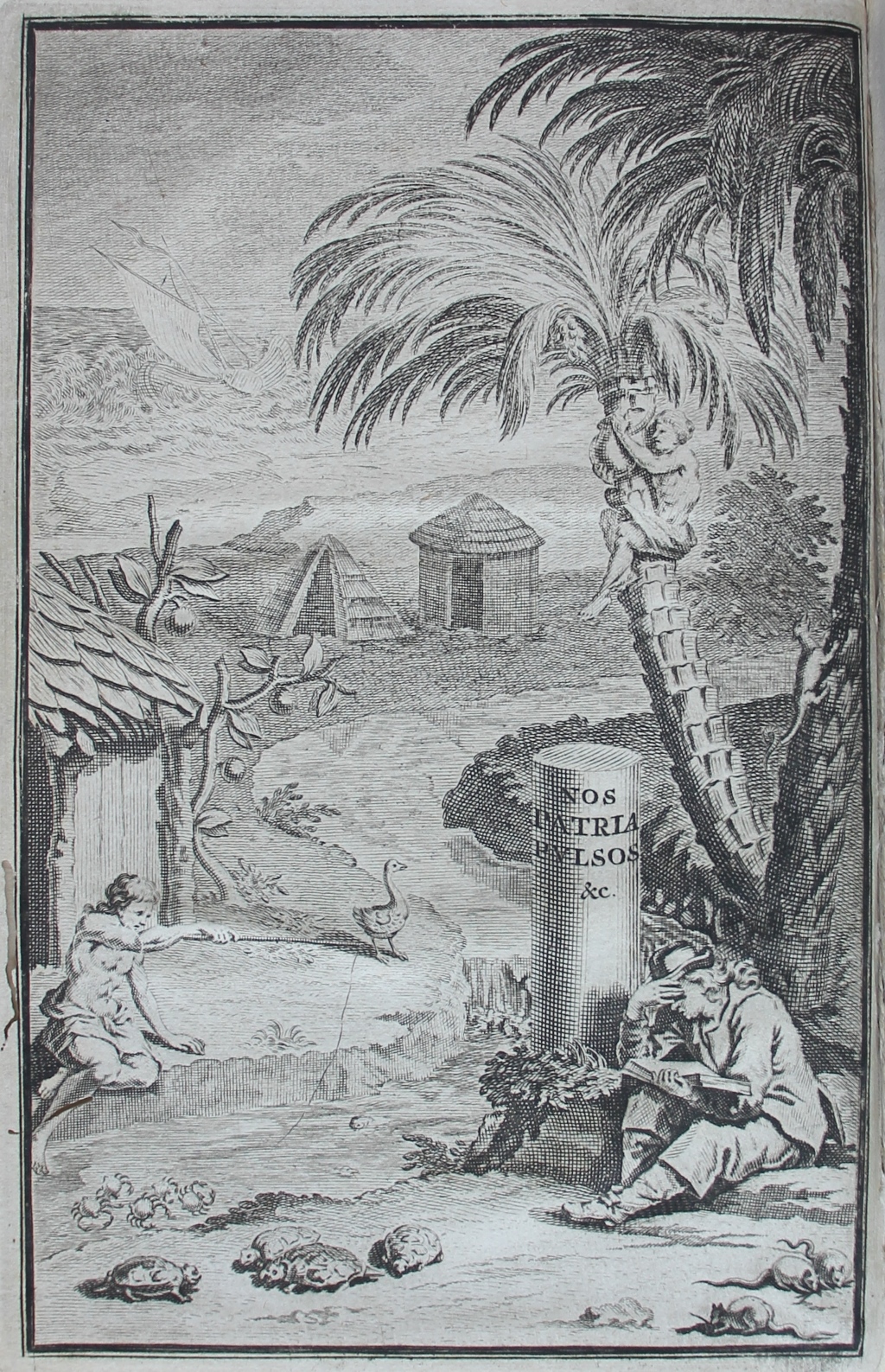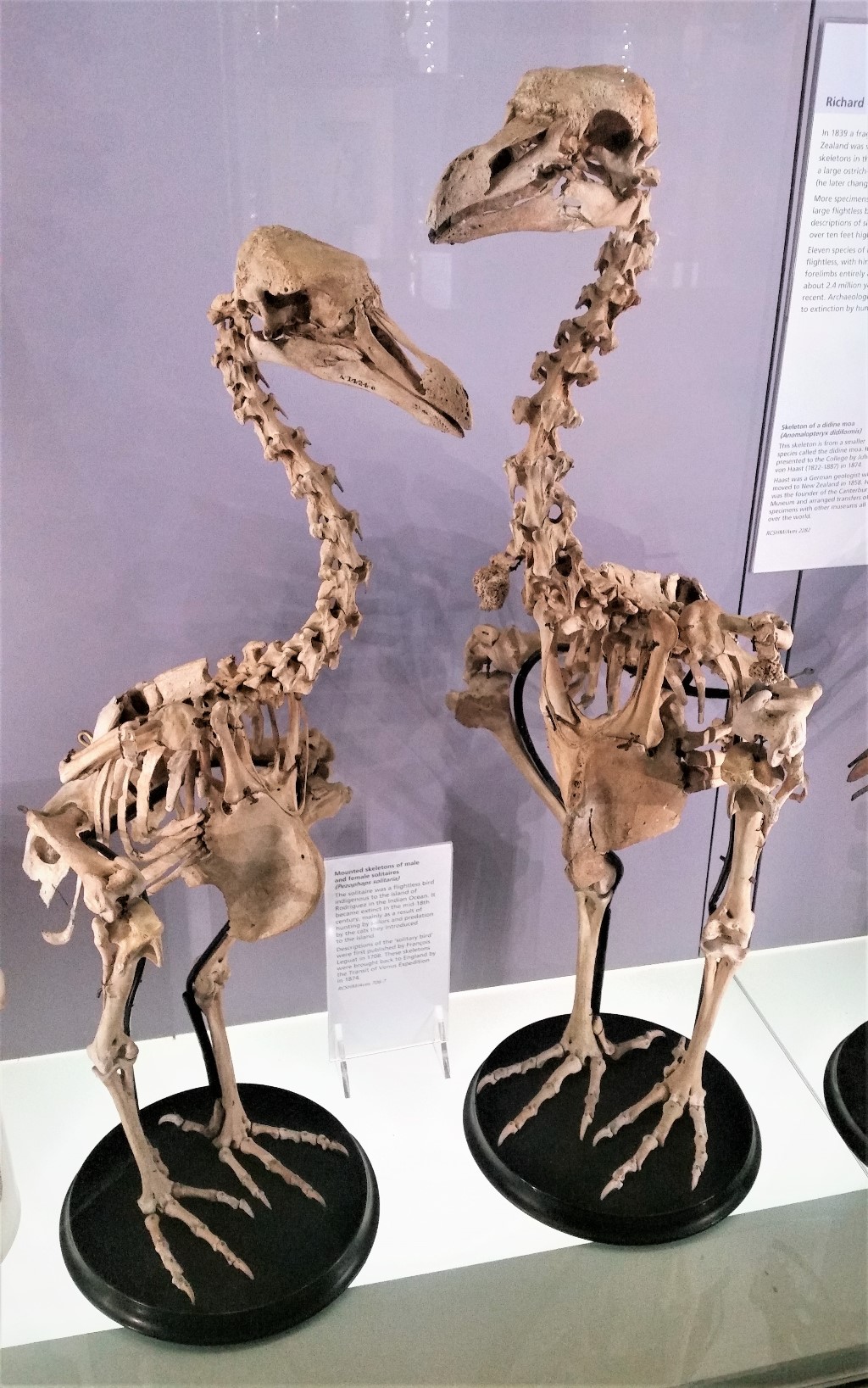Le Guat on the Solitary bird of Rodrigues Island
The dodo Raphus cucullatus of the Island of Mauritius was not the only unusual bird encountered by European explorers in the Mascarene Islands of the southwestern Indian Ocean. On Rodrigues Island, an island 574km east of Mauritius, another strange bird was lurking: the solitaire Pezophaps solitaria. This bird was described in detail in Worth’s copy of François Le Guat’s Voyage et avantures de François Leguat, & de ses compagnons, en deux isles desertes des Indes Orientales. Avec la Rélation des choses les plus remarquables qu’ils ont observées dans L’Isle Maurice, à Batavia, au Cap de Bonne-Esperance, dans L’Isle St. Helene, & en d’autres endroits de leur Route. Le tout enrichi de cartes & de figures (London, 1708).[1]

François Le Guat, Voyage et avantures de François Leguat, & de ses compagnons, en deux isles desertes des Indes Orientales. Avec la Rélation des choses les plus remarquables qu’ils ont observées dans L’Isle Maurice, à Batavia, au Cap de Bonne-Esperance, dans L’Isle St. Helene, & en d’autres endroits de leur Route. Le tout enrichi de cartes & de figures (London, 1708), i, p. 98.
François Le Guat (1637–1735), was a French Huguenot who, following the revocation of the Edict of Nantes in 1685, had joined with other Huguenots to flee France and set up a French colony on the island of Réunion – one of the Mascarene Islands.[2] He and his companions arrived on Rodrigues Island on 1 May 1691 and stayed there two years, giving him ample time to observe the mysterious Solitaires.[3] When he eventually made his way back to Europe he published an account of his journey and discoveries in French and English.
In it Le Guat provides us with the following information about his encounter with this remarkable bird:
Of all the Birds in the Island, the most Remarkable is that which goes by the Name of the Solitary, because ’tis very seldom seen in Company, tho’ there are abundance of them. The Feathers of the Males are of a brown, grey Colour: The Feet and Beak are like a Turkeys, but a little more crooked. They have scarce any Tail, but their Hind-part cover’d with Feathers is Roundish, like the Crupper of a Horse, they are taller than Turkeys. Their Neck is straight, and a little longer in proportion than a Turkeys, when it lifts up his Head. Its Eye is black and lively, and its Head without Comb or Cop. They never fly, their Wings are too little to support the weight of their Bodies; they serve only to beat themselves, and flutter when they call one another. They will whirl about for twenty or thirty times together on the same side, during the space of four or five Minutes: The Motions of their Wings makes then a noise very like that of a Rattle; and one may hear it two hundred Paces off: The Bone of their Wing grows greater towards the Extremity, and forms a little round Mass under the Feathers, as big as a Musket Ball: That and its Beak are the chief Defence of this Bird. ‘Tis very hard to catch it in the Woods, but easie in open Places, because we run faster than they, and sometimes we approach them without much Trouble. From March to September they are extreamly fat, and taste admirably well, especially while they are young, some of the Males weigh forty five pound.
The Females are wonderfully beautiful, some fair, some brown; I call them fair, because they are the colour of fair Hair: They have a sort of Peak like a Widow’s upon their Breasts, which is of a dun Colour. No one Feather is stragling from the other all over their Bodies, they being very careful to adjust themselves, and make them all even with their Beaks. The Feathers on their Thighs are round like shells at the end, and being there very thick, have an agreeable effect: They have two Risings on their Craws, and the Feathers are whiter than the rest, which livelily Represents the fine Neck of a Beautiful Woman. They walk with so much Stateliness and good Grace, that one cannot help admiring and loving them; by which means their fine Mein often saves their Lives. Tho’ these Birds will sometimes very familiarly come up near enough to one, when we do not run after them, yet they will never grow Tame: As soon as they are caught they shed Tears without Crying, and refuse all manner of Sustenance till they die.[4]

François Le Guat, Voyage et avantures de François Leguat, & de ses compagnons, en deux isles desertes des Indes Orientales. Avec la Rélation des choses les plus remarquables qu’ils ont observées dans L’Isle Maurice, à Batavia, au Cap de Bonne-Esperance, dans L’Isle St. Helene, & en d’autres endroits de leur Route. Le tout enrichi de cartes & de figures (London, 1708), frontispiece depicting the author with a Solitaire in the middle distance.
It is clear that, while solitaires might have been keen to keep their distance from the French colonists, Le Guat did not keep his distance from the birds for he also provides his readers with information about their organs:
We find in the Gizards of both Male and Female a brown Stone, of the bigness of a Hens Egg. ‘Tis somewhat rough, flat on one side, and round on the other, heavy and hard. We believe this Stone was there when they were hatched, for let them be never so young, you meet with it always. They have never but one of ’em, and besides, the Passage from the Craw to the Gizard is so narrow, that a Like Mass, of half the bigness cou’d not pals. It serv’d to whet our Knives, better than any other Stone whatsoever.[5]
Le Guat took a lively interest in their habitat and habits also:
When these Birds build their Nests, they choose a clean Place, gather together some Palm Leaves for that purpose and heap them up a foot and a half high from the Ground, on which they fit. They never lay but one Egg, which is much bigger than that of a Goose. The Male and Female both cover it in their turns, and the young is not hatch’d till at seven Weeks end: All the while they are sitting upon it, or are bringing up their young one, which is not able to provide for itself in several Months, they will not suffer any other Bird of their Species to come within two hundred yards round of the Place: But what is very singular, is, The Males will never drive away the Females, only when he perceives one he makes a noise with his Wings to call the Female, and she drives the unwelcome Stranger away, not leaving it till ’tis without her Bounds. The Female do’s the same as to the Males, whom she leaves to the Male, and he drives them away. We have observ’d this several times, and I affirm it to be true.[6]
He was also clearly interested in how the solitaires acted in unison:
The Combats between them on this occasion lasts sometimes pretty long, because the Stranger only turns about, and do’s not fly directly from the Nest: However, the others do not forsake it, till they have quite driv’n it out of their Limits. After these Birds have rais’d their young One, and left it to its self, they are always together, which the other Birds are not, and tho’ they happen to mingle with other Birds of the same Species, these two Companions never disunite. We have often remark’d, that some days after the young one leaves the Nest, a Company of thirty or forty brings another young one to it; and the new fledg’d Bird with its Father and Mother joyning with the Band, march to some bye Place. We frequently follow’d them, and found that afterwards the old ones went each their way alone, or in Couples, and left the two young ones together, which we call’d a Marriage.[7]
Indeed, so impressed was he by the social aspects of solitaire life that he lamented that humans did not model themselves on the peaceable solitaires.[8] Le Guat was obviously much taken by his avian companions – as we saw above, he states that ‘one cannot help admiring and loving them’.[9]

Mounted skeletons of a male and female solitaires (Pezophaps solitaria). The specimens are from the Hunterian Museum at the Royal College of Surgeons of England. This file was created by Emőke Dénes and is licensed under the Creative Commons Attribution-Share Alike 4.0 International license.
Le Guat’s account is invaluable because it gives us an in-depth description of the life of solitaires on Rodrigues Island in the last decade of the seventeenth century. As Paris notes, the veracity of Le Guat’s detailed observations have been confirmed, not only by other contemporary accounts but subsequent osteological discoveries.[10] This is all the more important because the solitaire of Rodrigues Island, like the dodo of Mauritius, is now extinct. While perhaps not as well-known as the dodo, the solitaire has been the focus of numerous archaeological digs on Rodrigues Island, inspired by a find in 1786 of bones of a solitaire. As Hume et al. note, the mid to later nineteenth century witnessed a number of explorations of caves on Rodrigues, intent on finding more bones of solitaires.[11] At times, the solitaire and the dodo were thought to be the same bird but the discovery of bones of the solitaire bird made it clear that it was not a dodo. Indeed, as Hume et al, note, the search for solitaire bones ultimately led to a search for dodo skeletons, the first being found on Mauritius in 1865.[12]
In fact both flightless birds were columbids, related to pigeons and doves. [13] Rodriguez-Pontes notes the solitaire’s ‘pigeon-like head’ and, based on his digital reconstructions of the solitaire (which in turn are based on contemporary reports such as those of Le Guat), suggests that the solitaire had ‘a morphology that can be considered as transitional between that of the Mauritian dodo and that of many extant pigeons and doves’.[14] Heupink et al. have explored the relation between the subfamily Raphinae (which includes the solitaire and dodo), and its relationship with the ‘morphologically very diverse Pigeon species’.[15] Having examined DNA sequencing for the Spotted Green Pigeon from specimens held in the World Museum, Liverpool, they have concluded that its closest relative was the Nicobar Pigeon, and following that, the dodo and solitaire.[16] This is important because it sheds light on how these flightless birds might have made it to these distant islands for Heupink et al. suggest that the ancestors of the dodos and solitaires might well have shared an ability to fly, using islands as stepping stones.[17]
The solitaire became extinct in the eighteenth century and the depictions of the bird in Le Guat’s book were one of the few images of the bird to be produced before that unhappy event. There were verbal descriptions of the bird in the 1720s by two other French visitors: Julien Tafforet and Jacques Thomas de Jonchée both commenting on the solitaire while visiting Rodrigues Island (in 1726 and 1729 respectively), but their descriptions were far less detailed than that of Le Guat. For instance Tafforet tells us that:
The solitaire is a large bird which weighs about forty or fifty pounds. They have an extremely large head with a manner of headband/frontlet to the face that one would say is black velvet. Their feathers are neither feathers nor hair; they are of light grey colour, with a little black on their backs. Strutting proudly about either alone or in pairs, they preen their plumage or fur with their beak and keep themselves very clean. Their toes are furnished with hard scales and can run quickly among rocks. They are well adapted among the rocks where a man, however agile, can hardly catch them. They have a very short beak of about an inch in length, and which is sharp. They, nevertheless, do not attempt to hurt anyone. An exception is when they find someone before them, and then when hard pressed will try to bite him. They have a small stump of a wing, which has a sort of bullet at its extremity to serve for defence.[18]
Unfortunately for the solitaire, it could not run far enough away from inquisitive humans.
Text: Dr Elizabethanne Boran, Librarian of the Edward Worth Library, Dublin.
Sources
Heupink, Tim H., Hein van Grouw and David M. Lambert, ‘The mysterious Spotted Green Pigeon and its relation to the Dodo and its kindred’, Evolutionary Biology, 14, no. 136 (2014), 1–6.
Hume, J. P., L. Steel, A. A. André and A. Meunier, ‘In the footsteps of the bone collectors: nineteenth-century cave exploration on Rodrigues Island, Indian Ocean’, Historical Biology: An International Journal of Paleobiology, 27, no. 2 (2015), 265–86.
Le Guat, François, Voyage et avantures de François Leguat, & de ses compagnons, en deux isles desertes des Indes Orientales. Avec la Rélation des choses les plus remarquables qu’ils ont observées dans L’Isle Maurice, à Batavia, au Cap de Bonne-Esperance, dans L’Isle St. Helene, & en d’autres endroits de leur Route. Le tout enrichi de cartes & de figures (London, 1708),
Le Guat, François, A new voyage to the East-Indies by Francis Leguat and his companions. Containing their adventures in two desart islands, And an Account of the most Remarkable Things in Maurice Island, Batavia, at the Cope of Good Hope, the Island of St. Helena, and other Places in their Way to and from the Desart Isles. Adorn’d with maps and figures (London, 1708). This English translation is not in the Worth Library.
Paris, Jolyon C., The dodo and the solitaire: a natural history (Bloomington, Indiana, 2013).
Rodriguez-Pontes, Martin A., ‘Digital reconstruction of Rodrigues Solitaire (Pezophaps solitaria) (Aves: Columbidae) physical appearance based on early descriptive observation and other evidence’, Historical Biology: An International Journal of Paleobiology, 28, no. 3 (2016), 398–414.
__
[1] Le Guat was not the only one to encounter Solitaires on Rodriguez Island in the 1690s: in 1691 the Huguenot captain Antoine Valleau, who had led the expedition of which Le Guat was a member, had encountered ‘birds larger than the turkey [cocq’s d’Inde] called solitaries, which one takes by hand’ (he subsequently wrote up his report in 1692): Rodriguez-Pontes, Martin A., ‘Digital reconstruction of Rodrigues Solitaire (Pezophaps solitaria) (Aves: Columbidae) physical appearance based on early descriptive observation and other evidence’, Historical Biology: An International Journal of Paleobiology, 28, no. 3 (2016), 408.
[2] Paris, Jolyon C., The dodo and the solitaire: a natural history (Bloomington, Indiana, 2013), kindle version.
[3] Ibid.
[4] Le Guat, François, A new voyage to the East-Indies by Francis Leguat and his companions. Containing their adventures in two desart islands, And an Account of the most Remarkable Things in Maurice Island, Batavia, at the Cope of Good Hope, the Island of St. Helena, and other Places in their Way to and from the Desart Isles. Adorn’d with maps and figures (London, 1708), pp 71–2. This English translation is not in the Worth Library.
[5] Ibid., p. 72.
[6] Ibid., pp 72–3.
[7] Ibid., pp 73–4.
[8] Ibid., p. 74.
[9] Ibid., p. 72.
[10] Paris, The dodo and the solitaire: a natural history, kindle version.
[11] Hume, J. P., L. Steel, A. A. André and A. Meunier, ‘In the footsteps of the bone collectors: nineteenth-century cave exploration on Rodrigues Island, Indian Ocean’, Historical Biology: An International Journal of Paleobiology, 27, no. 2 (2015), 265–86.
[12] Ibid., 270.
[13] Ibid., 265 and 270.
[14] Rodriguez-Pontes, ‘Digital reconstruction of Rodrigues Solitaire (Pezophaps solitaria)’, 413.
[15] Heupink, Tim H., Hein van Grouw and David M. Lambert, ‘The mysterious Spotted Green Pigeon and its relation to the Dodo and its kindred’, Evoluntionary Biology, 14, no. 136 (2014), 1.
[16] Ibid., 4.
[17] Ibid., 5.
[18] Quoted in Rodriguez-Pontes, ‘Digital reconstruction of Rodrigues Solitaire (Pezophaps solitaria)’, 402.